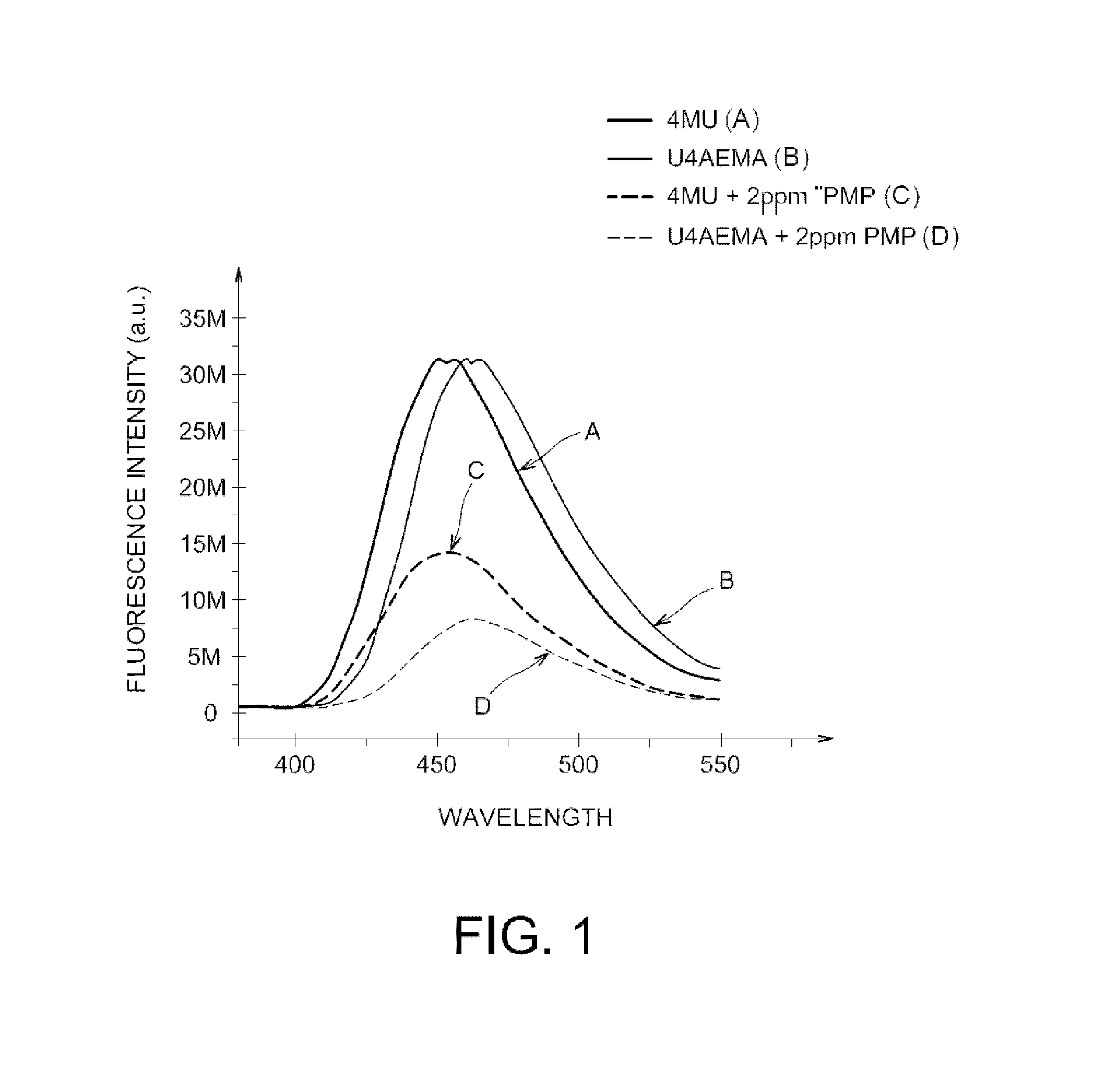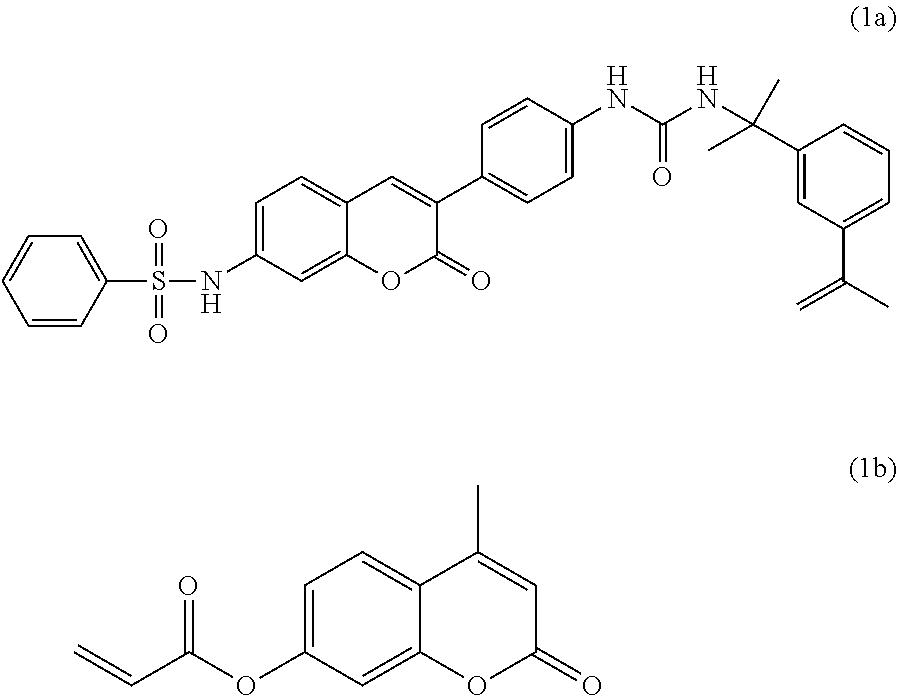Fluorescent polymers of 7-hydroxycoumarin compounds, chemical sensors comprising them, and polymerizable fluorescent compound of 7-hydroxycoumarin
a technology of 7-hydroxycoumarin and polymerizable fluorescent compound, which is applied in the field of fluorescence polymers, can solve the problems of insufficient dispersion of dye in polymers, affecting the dispersion of dye, etc., and achieves the effect of easy polymerization of fluorescent compound
- Summary
- Abstract
- Description
- Claims
- Application Information
AI Technical Summary
Benefits of technology
Problems solved by technology
Method used
Image
Examples
example 1
Synthesis of the monomer Ethyl-2-methacrylate Umbelliferone-4-acetate (U4AEMA)
[0181]
[0182]In a flask, 1 g (4.5 mmol) of umbelliferone-4-acetic acid and 40 mL of non-stabilized anhydrous tetrahydrofurane are introduced, giving a yellow, clear, limpid solution. Next, 0.48 g (4.5 mmol) of ethylpyridine, 2.96 g (22.5 mmol) of 2-hydroxyethyl methacrylate and 0.94 g (4.5 mmol) of dicyclohexylcarbodiimide dissolved before hand in 35 mL of non-stabilized anhydrous tetrahydrofurane, are added to the solution, away from light. The mixture is stirred at room temperature for 5 hours. After removing the dicyclohexylurea precipitate by filtration, the solvent is evaporated, away from light. The product is purified on a silica gel column eluted with a heptane / acetone (3:1 v / v) mixture. After evaporation of the solvent, the pure product is obtained as a pale yellow solid. After drying, a yield of 68% is obtained.[0183]1H NMR (200 MHz, CDCl3) 5 (ppm) 1.91(3H, t, J=1.5 Hz, —CH3: H1), 3.78 (2H, s, CH2...
example 2
Synthesis of the homopolymer poly(Ethyl-2-methacrylate Umbelliferone-4-acetate) (poly U4AEMA)
[0189]
[0190]In a three-necked flask, 300 mg (0.9 mmol) of U4AEMA and 6 mg (˜2% by weight) of azobisisobutyronitrile (AIBN) as an initiator, are dissolved in 12 mL of non-stabilized anhydrous tetrahydrofurane (THF), giving a yellow, clear, limpid solution. The mixture is placed for 5 minutes in an ultrasonic bath away from light. The flask is then surmounted with a cooler and placed in an ice bath while argon bubbling is carried out for 10 minutes in the solution. The reaction mixture is heated to 60° C. for 20 hours with magnetic stirring and slight argon flushing, sweeping.
[0191]The polymer formed is precipitated from 200 mL of ether. The precipitate is then filtered and rinsed. The obtained solid is taken up in THF, and then again precipitated from the ether. After filtration and rinsing, the solid is dried until its mass is constant. The polymer is recovered as a fluorescent yellow solid ...
example 3
Synthesis of the copolymer poly(umbelliferone-4-ethyl acetate-2-methacrylate-co-styrene)
[0198]In a perfectly dry three-necked flask surmounted with a cooler, 5 mg (15 μmol) of U4AEMA and 20 mg (˜2% by weight) of AIBN are dissolved in 20 mL of non-stabilized anhydrous tetrahydrofurane (THF), introduced under argon. Next, 1 g (9.6 mmol) of purified styrene is added under argon. The flask is then placed in an ice bath while argon bubbling is carried out for 20 minutes in the solution. The reaction mixture under an inert atmosphere is heated to 60° C. for 40 hours with magnetic stirring. The polymer formed is precipitated from 200 mL of methanol. The precipitate is then filtered and rinsed. The obtained solid is taken up in THF, and then again precipitated from methanol. After filtration and rinsing, the solid is dried to constant mass. The polymer is recovered as fluorescent white solid with a yield of 2%.[0199]CPC (?S ,E,tan-6a. THF)[0200](Kar tablet) v km-) 3433 in, 3100 (Sy. 3081fra...
PUM
| Property | Measurement | Unit |
|---|---|---|
| diameter | aaaaa | aaaaa |
| diameter | aaaaa | aaaaa |
| excitation wavelength λx | aaaaa | aaaaa |
Abstract
Description
Claims
Application Information
 Login to View More
Login to View More - R&D
- Intellectual Property
- Life Sciences
- Materials
- Tech Scout
- Unparalleled Data Quality
- Higher Quality Content
- 60% Fewer Hallucinations
Browse by: Latest US Patents, China's latest patents, Technical Efficacy Thesaurus, Application Domain, Technology Topic, Popular Technical Reports.
© 2025 PatSnap. All rights reserved.Legal|Privacy policy|Modern Slavery Act Transparency Statement|Sitemap|About US| Contact US: help@patsnap.com



